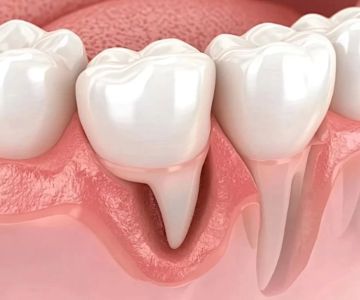Treatment for Infected Tooth Root and Pulp: Comprehensive Guide
- 1. Understanding Tooth Infection and Its Causes
- 2. Symptoms of an Infected Tooth Root and Pulp
- 3. Treatment Options for Infected Tooth Root and Pulp
- 4. Preventing Further Tooth Infections
- 5. When to Seek Immediate Dental Help
1. Understanding Tooth Infection and Its Causes
Tooth infections often begin when bacteria penetrate the tooth's outer layers, affecting the pulp and root. The infection can occur due to untreated cavities, gum disease, or trauma to the tooth. If left unchecked, it may lead to severe pain and even tooth loss. The pulp, which houses blood vessels and nerves, can easily become infected when the protective enamel or dentin is compromised.
Infection can spread quickly, making it essential to recognize the symptoms early. But what causes these infections to spiral out of control? Poor oral hygiene, untreated dental decay, and cracks in the tooth are common culprits. Additionally, ignoring regular dental check-ups or putting off necessary treatments can increase the risk of infection.
2. Symptoms of an Infected Tooth Root and Pulp
Recognizing the symptoms of an infected tooth root and pulp is critical to seek timely dental treatment. The most common signs include:
- Severe tooth pain, especially when chewing or touching the affected tooth.
- Swelling and redness around the tooth or gums.
- Bad breath or an unpleasant taste in the mouth due to the infection.
- Sensitivity to hot and cold temperatures.
- Fever in advanced cases, indicating that the infection has spread.
If you notice any of these symptoms, it's crucial to consult a dentist as soon as possible to prevent further complications.
3. Treatment Options for Infected Tooth Root and Pulp
There are several treatment options available for an infected tooth root and pulp. The most common methods include:
3.1 Root Canal Therapy
A root canal is one of the most effective treatments for an infected tooth. During this procedure, the dentist removes the infected pulp, cleans the root canals, and fills them with a special material to prevent further infection. Although this procedure can be intimidating, it is highly effective at saving the tooth and relieving pain.
3.2 Tooth Extraction
In cases where the infection is severe and a root canal is not viable, a tooth extraction may be necessary. This procedure removes the entire tooth, and while it's a last resort, it may be the best option to prevent the spread of infection to surrounding teeth.
3.3 Antibiotics
Antibiotics may be prescribed to control the infection and prevent it from spreading, particularly if the infection has reached an advanced stage. These are typically used in conjunction with other treatments like root canal therapy.
4. Preventing Further Tooth Infections
While treating an infected tooth is crucial, preventing future infections is just as important. Regular dental check-ups, proper brushing, and flossing habits are key in avoiding tooth decay and gum disease, which can lead to pulp and root infections. It's also essential to avoid sugary foods and drinks that can accelerate tooth decay and keep your teeth strong.
Using fluoride toothpaste and mouthwash regularly can help strengthen enamel and prevent bacterial build-up in your mouth. Additionally, protecting your teeth from physical damage by wearing mouthguards while playing sports or during sleep (if you grind your teeth) can go a long way in preventing tooth infections.
5. When to Seek Immediate Dental Help
In some cases, the infection may become severe, leading to more than just tooth pain. If you experience any of the following signs, it's time to seek immediate dental help:
- Severe, unrelenting tooth pain that does not subside with over-the-counter pain relievers.
- Swelling in the face or neck area, indicating that the infection has spread.
- Difficulty swallowing or breathing, which could indicate a life-threatening situation.
Early intervention is key to preventing long-term damage and preserving your dental health.







 Westgate Dental Arts
Westgate Dental Arts Coventry Family Dental
Coventry Family Dental Familia Dental
Familia Dental Dr. Daniel S. Fife, DDS
Dr. Daniel S. Fife, DDS Dentistry At Suburban Square: Michael I. Wollock, DMD
Dentistry At Suburban Square: Michael I. Wollock, DMD Comfort Care Dental
Comfort Care Dental The Importance of Oral Health Education During Pregnancy for a Healthy Pregnancy
The Importance of Oral Health Education During Pregnancy for a Healthy Pregnancy Why Skipping Dental Checkups Can Lead to Bigger Oral Health Problems
Why Skipping Dental Checkups Can Lead to Bigger Oral Health Problems Advantages of Porcelain Dental Restorations
Advantages of Porcelain Dental Restorations Best Tips for Brushing Your Teeth Properly for Healthy Gums: Essential Techniques for Oral Health
Best Tips for Brushing Your Teeth Properly for Healthy Gums: Essential Techniques for Oral Health How Can Diabetes Cause Tooth and Gum Problems? Preventing and Managing Oral Health Issues
How Can Diabetes Cause Tooth and Gum Problems? Preventing and Managing Oral Health Issues Healthy Habits for Promoting Good Oral Health and Hygiene: Tips for a Healthy Smile
Healthy Habits for Promoting Good Oral Health and Hygiene: Tips for a Healthy Smile